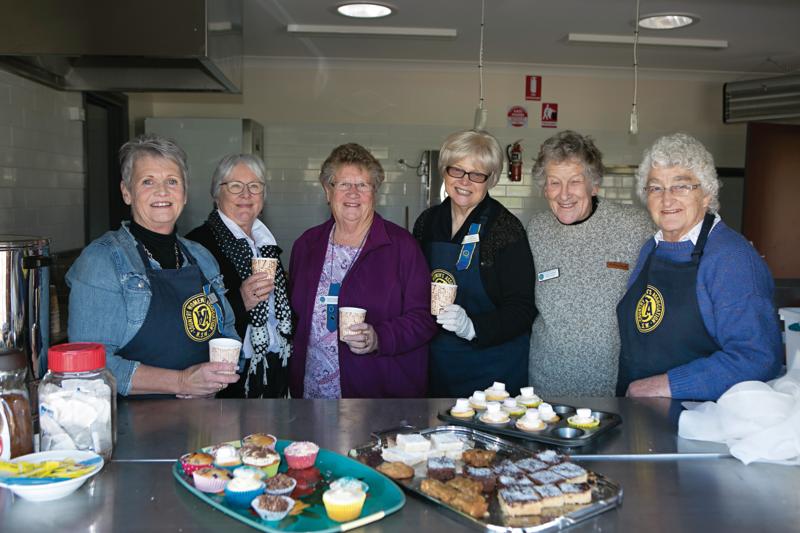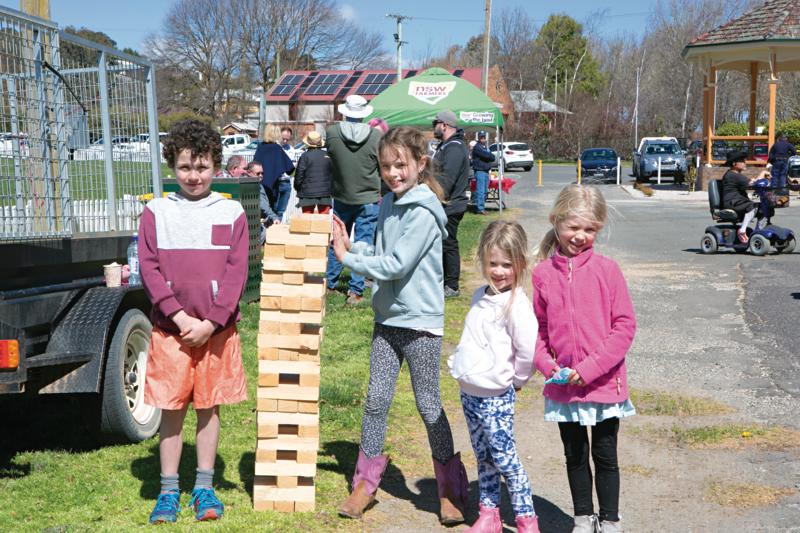SOMETIMES you just need to forget the drought – and bouncy castles and tug-of-war can be just the ticket. With the help of NSW Farmers and the Country Women’s Association (CWA), the little village of Millthorpe hosted a ‘Picnic Drought Get Together’ that encouraged more than 150 farmers and their families to get off the farm and enjoy a good dose of community hospitality.
“We did over 400 steak and sausage sandwiches on the day,” says Sam Yeates, president of the Millthorpe Village Committee, which organised the event at the local Redmond Oval.
“The focus was for families to have some fun with events like spud and spoon races, but we also combined it with drought support information.”
The Central Tablelands village, which sits between Orange and Blayney, was assisted at the event by NSW Farmers’ Orange branch, which added fresh fruit to the picnic menu, providing apples, oranges, watermelons and rockmelons. The Millthorpe CWA also chipped in with cakes, tea and coffee. Orange branch chair Bruce Reynolds says NSW Farmers’ members wanted to promote the health benefits of fresh fruit and give something back to the community.
“So many communities like Millthorpe have donated money and other goods to farmers, so it was a little thank you back from the farmers,” Bruce says. “Local growers provided the apples and organised donations of rockmelons and watermelons from the Sydney Markets.”
 Millthorpe CWA members Kay Nixon, Dawn Mobbs, Gwen Aspinall, Susan Chudleigh, Susan Sanders and Beverley Nesbitt. The CWA donated slices, cupcakes – and their time – to support the event.
Millthorpe CWA members Kay Nixon, Dawn Mobbs, Gwen Aspinall, Susan Chudleigh, Susan Sanders and Beverley Nesbitt. The CWA donated slices, cupcakes – and their time – to support the event.
Bruce, who grew up on a farm near Millthorpe, says it is important for the Association to be involved in community events and encourage farmers to socialise during hard times.
Sam Yeates has a small farm on the outskirts of the village, producing lamb and beef, and says the community was happy to share some positive vibes with farmers.
“The drought can be very distressing for farmers, particularly in regards to the impact on our livestock,” he says. “Something as simple as a picnic and social family gathering can really help. It was not a fundraising event but an opportunity for people to have a pleasant day and perhaps share their thoughts at a difficult time.”
Like a growing number of tourists, Sam has fallen for Millthorpe’s historical charms since moving here seven years ago. Once famed for its potato and pea production, the village has reinvented itself by building on its heritage and character to capture the all-important tourist market. A quick glance at Millthorpe village reviews on travel websites shows the strategy is working, with a flurry of positive comments about the food, wine, historical buildings and friendly atmosphere.
“I love the place,” Sam says. “It’s a great community and the village really fires up on a Thursday, Friday and Saturday night. We are trying to make it a seven-day-a- week destination and the train station will certainly help with that.”
RELATED DROUGHT STORIES:
-
The drought hay crisis
-
Donated hay survey: where drought-affected farmers found relief
-
26 year old silage offers drought relief for Tamworth farmer
MILLTHORPE STATION - RAIL REVIVAL AFTER LOBBYING
After lobbying by the community, construction is now underway on a $1.1 million project to extend the platform and reopen the Millthorpe station, which was closed after the track was realigned in the late 1980s. Sam says the village committee is gearing up for a reopening of the station in February or March next year.
 Bouncy castle for children at the Picnic Drought Get Together in Millthorpe NSW.
Bouncy castle for children at the Picnic Drought Get Together in Millthorpe NSW.
The station opened in 1877 and became central to the prosperity of the village and its agricultural production. The flour mill, built by a progressive group of farmers in 1884, depended on the railway as did local farmers cutting and supplying chaff for a rapidly expanding Sydney. Millthorpe became one of the largest rail centres in the state, shipping flour, chaff and later potatoes to Sydney and other markets.
It was during this time of prosperity in the late 19th and early 20th centuries that the historic charms of the village took shape. Imposing buildings were built to serve the agricultural needs of the district and many are still standing, now housing restaurants (including the regularly hatted Tonic), providores, cellar doors, gift shops and galleries.
“We are going to put some mid-week and weekend tourist packages together to capitalise on the station reopening and encourage visitors from Sydney and other markets to come up via the train,” he says.
“This will be a real tourism boost for Millthorpe. It’s also great news for locals, who will be able to catch a train to Orange at midday and come back in the afternoon.”
RELATED COMMUNITY STORIES:
-
Bingara: a rural community success story
-
Coleambally community is strong
 Fun and games for Xavier Ash and Imogen, Silvia and Genevieve Anagnostaras with the giant Jenga.
Fun and games for Xavier Ash and Imogen, Silvia and Genevieve Anagnostaras with the giant Jenga.
NSW Farmers’ member Bruce Gordon has spent a lifetime on farms in the Millthorpe area and has seen a significant shift towards small lifestyle farms in recent years. He says the wheat and horticulture glory days are long gone, but agriculture is still important to the community with the focus now on lamb and beef production.
“There is still some horticulture as you head towards Mount Canobolas and nearby vineyards supply to two busy cellar door outlets in Millthorpe,” Bruce says. “It still is productive country with the added benefit of having a town with tourism assets.”
Sam Yeates says the village had a major setback with the downturn in demand for the local flour milling, chaff and potatoes. But the farming legacy was preserved in the village streetscapes – and has proved to be a perfect fit with the recent market shift to tourism and local food and wine.
MILLTHORPE FAST FACTS
Millthorpe Population (2016 census)
1,253
Average house price (SEPTEMBER 2018)
$450,000
Unemployment rate (2016 census)
4%
FARMING HISTORY OF MILLTHORPE
1823
The traditional landowners are the Wiradjuri people. European settlement began with the establishment of a government stock station.
1840-1880
The area developed as a farming centre and orchards were established in the 1860s. The village was known as Spring Grove.
1870s
A railway station opened at Spring Grove giving the region a considerable boost.
1880s
A large flour mill opened, and in recognition of this, the village name was changed to Millthorpe.
1960s-1970s
The region was one of the largest potato-growing areas supplying Sydney Markets.
1980s-1990s
Demand for the region’s potatoes dropped as buyers turned to produce grown on sandier soils, with less dirt on them. Declining prices and competition from big growers saw the industry contract.
Present
The area now produces lamb, beef, some horticulture and wine, and there is a growing trend for ‘lifestyle farms’. The town’s historic buildings have been restored and tourism is on the up.
READ MORE - The tourism boom
- From fleece to farmed meat: how alpaca farmers are owning their niche
-
View to the future: Byron Bay dairy diversifies into farm tourism